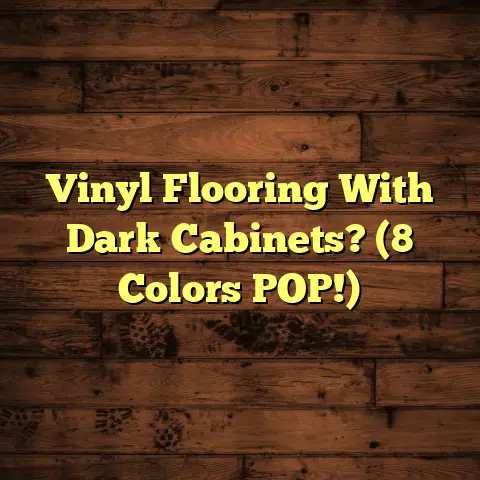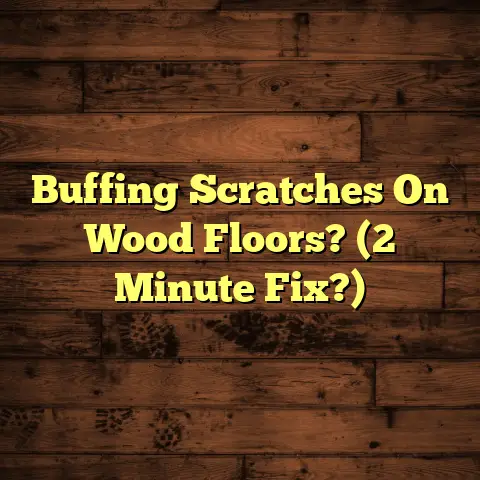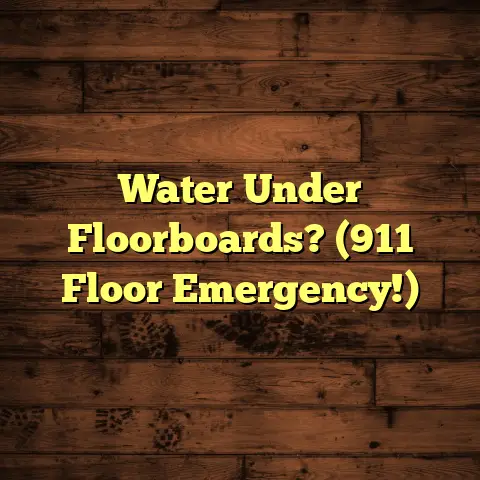Mold Under Hardwood? (5 Warning Signs ASAP!)
Imagine this: you walk into your home, the scent of freshly brewed coffee fills the air, and your hardwood floors gleam warmly. It’s your sanctuary. But what if, beneath that beautiful surface, a hidden enemy is growing? I’m talking about mold, and it’s a bigger problem than you might think.
I’ve been a flooring contractor for over 15 years, and I’ve seen firsthand the damage mold can do. It’s not just about aesthetics; it’s about your health and the structural integrity of your home. Let’s dive into the warning signs you need to know now.
1. Introduction to Mold in Homes
Mold is everywhere. It’s a natural part of our environment, but it becomes a problem when it starts growing indoors. Hardwood floors, especially those in basements or areas with high humidity, are prime targets.
Why? Hardwood is organic, and mold loves organic material. Add moisture, and you’ve got the perfect breeding ground.
Early detection is critical. The longer mold goes unchecked, the more damage it causes, and the more expensive it is to remediate. Think of it like a small leak in your roof: ignore it, and you’ll soon have a much bigger problem.
2. Warning Sign 1: Unpleasant Odors
Ever walk into a room and get a whiff of something musty or earthy? That’s a red flag. Mold produces volatile organic compounds (VOCs) as it breaks down organic material. These VOCs are what you smell.
It’s not always a strong, overpowering odor. Sometimes it’s subtle, like a damp basement smell that you can’t quite place.
I remember one client who kept complaining about a “weird smell” in their living room. They thought it was their dog! Turns out, they had a slow leak under their dishwasher, which led to mold growth under the hardwood. We had to pull up a significant portion of the floor to fix it.
Pro Tip: If you notice a persistent musty odor, don’t just mask it with air freshener. Investigate!
3. Warning Sign 2: Visible Discoloration
This one’s a bit more obvious, but mold can be sneaky. Look for dark spots, stains, or a general discoloration on your hardwood floors. It might appear as black, green, white, or even orange.
Different types of mold have different colors. For example:
-
Black mold (Stachybotrys chartarum): Often dark green or black and slimy.
-
Aspergillus: Can be green, yellow, brown, or black.
-
Cladosporium: Usually green or black.
The key is to differentiate between a normal stain and something that looks like mold growth. If you’re unsure, take a close look with a magnifying glass. Mold often has a fuzzy or textured appearance.
I once worked on a house where the homeowners had noticed dark stains near their baseboards. They initially thought it was just dirt, but upon closer inspection, it was mold creeping up from under the floor. The source? A leaky pipe hidden behind the wall.
Important Note: Don’t just wipe away the discoloration. That might spread the mold spores.
4. Warning Sign 3: Warping or Buckling of Floors
Hardwood and water don’t mix. When hardwood absorbs moisture, it expands. This expansion can cause the boards to warp, buckle, or even lift off the subfloor.
Here’s what to look for:
-
Cupping: The edges of the boards are higher than the center.
-
Crowning: The center of the boards is higher than the edges.
-
Buckling: The boards are lifting up in a wave-like pattern.
I’ve seen cases where entire hardwood floors had to be replaced because of severe warping caused by mold and moisture. One client had a pipe burst in their basement, and the resulting water damage led to extensive mold growth and floor deformation. The cost of the repair was significant.
Remember: Even small amounts of moisture can cause warping over time.
5. Warning Sign 4: Increased Allergy Symptoms
Mold releases spores into the air, which can trigger allergies and respiratory problems. If you notice an increase in allergy symptoms, such as:
- Sneezing
- Coughing
- Runny nose
- Watery eyes
- Skin rashes
It could be a sign of mold growth in your home.
The National Institute of Allergy and Infectious Diseases (NIAID) states that mold exposure can exacerbate asthma symptoms and trigger allergic reactions in sensitive individuals.
I had a client who suffered from chronic sinusitis. They tried everything, from allergy medications to nasal sprays, but nothing seemed to help. It turned out they had mold growing under their kitchen floor, and once we removed it, their symptoms improved dramatically.
Takeaway: Don’t dismiss allergy symptoms. They could be a sign of a hidden problem.
6. Warning Sign 5: Persistent Humidity
Mold thrives in humid environments. If you have high humidity levels in your home, you’re creating the perfect conditions for mold growth.
Signs of high humidity include:
- Condensation on windows
- Damp or clammy feeling
- Musty odors
- Visible mold growth (of course!)
According to the EPA, indoor humidity levels should be kept between 30-50% to prevent mold growth.
I always recommend that my clients invest in a humidity monitor. These are inexpensive devices that measure the humidity levels in your home. If the humidity is consistently above 60%, you need to take action.
I remember a client who lived in an older home with poor ventilation. They had high humidity levels year-round, and mold was a constant problem. We installed a dehumidifier and improved the ventilation in their home, which significantly reduced the humidity and prevented further mold growth.
Pro Tip: Use a dehumidifier, improve ventilation, and fix any leaks promptly to keep humidity levels in check.
7. Conclusion
Mold under hardwood is a serious issue that can affect your health and your home’s value. Being vigilant about these five warning signs can help you catch the problem early and prevent further damage.
- Unpleasant Odors: Don’t ignore that musty smell.
- Visible Discoloration: Look for dark spots or stains.
- Warping or Buckling of Floors: Check for signs of moisture damage.
- Increased Allergy Symptoms: Pay attention to your body.
- Persistent Humidity: Monitor the humidity levels in your home.
If you suspect you have mold, don’t hesitate to call a professional. Mold remediation is not a DIY project. It requires specialized equipment and knowledge to safely remove the mold and prevent it from spreading.
Addressing mold issues promptly is crucial. The longer you wait, the worse the problem will become, and the more it will cost to fix. Take action now to protect your health and your home.
I hope this article has been helpful. Remember, a healthy home starts with awareness and proactive measures. Don’t let mold steal your peace of mind!





